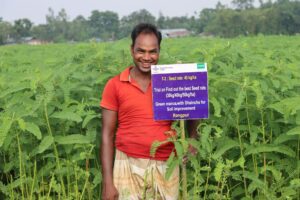
According to recent estimates by the United Nations, the world population will reach 7 billion in October 2011, and this number could rise to 9 billion by 2050 (see Monitoring an inconvenient divergence ). Nearly all of the growth—97%— is projected to come from developing countries, especially in Africa and Asia. Demand for rice is now growing faster than rice production. If nothing is done to ensure consistent and adequate rice supplies, the price of rice will continue to rise.
Rice supply and population growth
Asia represents about 90% of global rice production and consumption. It is also home to many millions of poor and hungry people who depend on rice for most of their calorie requirements. Many of them are poor farmers who not only consume rice but also grow it on small plots of less than 2 hectares. In fact, the International Rice Research Institute (IRRI) reports that nearly two-thirds of the world’s poor live in rice-producing areas in Asia. Current trends in population growth are expected to push this share even higher. Africa also has significant rice consumption and a large number of poor people.
Global rice demand is expected to rise in the coming decades, albeit in different amounts across regions. These changes in demand are mainly due to population growth, rising incomes, urbanization, and changing food preferences. At the global level, per capita rice consumption may become flat, but will increase in Africa, the Middle East, and the Americas while it will decline in some Asian countries that are experiencing diet shifts due to higher incomes and urbanization. Rice production, on the other hand, has slowed down, thus tightening rice supplies. Production growth has lagged for several reasons, including stagnant or declining crop yields, underinvestment in agricultural research and development, increasing land and water constraints for agriculture, increased input costs, and increased labor costs due to urbanization and industrialization. In the coming years, climate change is expected to put additional pressure on rice production systems, further tightening rice supplies.
The surges in food prices in 2007-08 and 2010-11 and the rapid depletion of global food stocks reveal that the world is increasingly vulnerable to food shortages or crises. As the populations of rice-producing and -consuming regions expand rapidly, concrete actions must be taken to boost production and secure rice supplies, especially for the millions of poor people who reside in these regions.
What must be done?
Asia’s experience during the Green Revolution—when the introduction of improved rice varieties led to higher rice yields and output—shows that technology is the key to spurring rapid growth in rice production. In addition to bridging the gap between demand and supply, rice productivity growth will also have large poverty reduction impacts as many rice producers are poor small farmers that depend on rice production for their livelihoods. New technologies, including postharvest technologies, must be rolled out continually on a large scale to achieve these impacts.
Recent strides in rice technology development and delivery are promising. Rice hybrids that are high-yielding, resistant to pests and diseases, and tolerant of environmental stresses are being developed and are increasingly available to farmers. Around 20 million hectares of hybrid rice are now grown globally, with the largest share, 85%, grown in China, according to IRRI. Biofortified rice, enriched with micronutrients such as vitamin A and zinc, has also been developed and has large potential to significantly improve the nutrition of poor consumers. To ensure environmental sustainability, technologies for the mitigation of greenhouse gas emissions in rice production should be promoted since rice production is one of the largest agricultural sources of methane emissions.
Although technology is a must to meet the increasing demand for rice, technology alone is not enough. Policy and market incentives are also needed to promote production growth, especially among small farmers. Investments are needed to improve small farmers’ access to high-yielding seeds and fertilizer, as well as to encourage them to diversify into high-value commodities or nonfarm activities. To help them cope with risks that stem from weather shocks, innovative risk management mechanisms, such as weather-based index insurance, must be strongly promoted. Access to financial services is also crucial for smallholder farmers, and emerging initiatives such as community banking have proved helpful.
To enable small farmers to participate profitably in global rice supply chains, they need to be linked to high-value markets. Institutional innovations such as farmer associations and contract farming schemes can help reduce market transaction costs and increase access to information. Investments in rural infrastructure will also be crucial to enhance the efficiency and profitability of the rice supply chain. In the trade arena, national governments must refrain from imposing export bans that tighten food markets and dampen production incentives. Strategic rice reserves such as the ASEAN Plus Three Emergency Rice Reserve are critical to ensure that the poor have access to adequate food, especially during emergencies. To successfully meet the food needs of a rapidly growing population, the implementation of these actions is imperative.
_________________________________________
Dr. Fan is the director general of the International Food Policy Research Institute in Washington, D.C.









